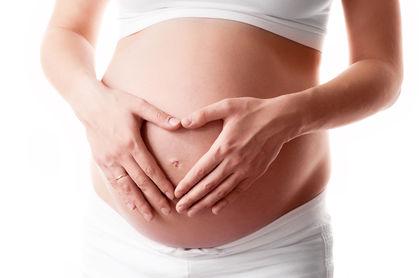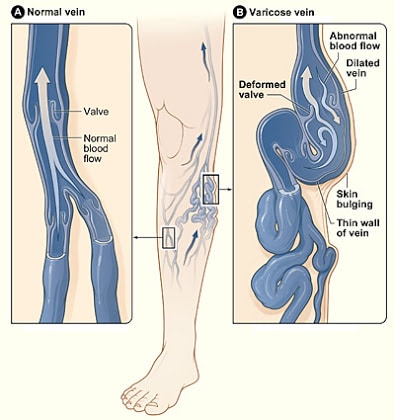Varicose veins are veins that are in the superficial compartment of the leg that have become enlarged, swollen, twisted, and/or bulging due to venous reflux disease. The visible veins can be many colors but are most commonly red, blue or flesh-toned. The bulging veins most often appear on the thighs, back of the calves, and the inside of the legs.
Pregnant women may experience varicose veins in the vaginal, pelvic and buttocks area. When these veins appear they may indicate an issue of venous reflux disease in the legs or may be a symptom of a pelvic venous issue. At Precision, we can help diagnose all venous issues including that of pelvic venous insufficiency.
To learn more about varicose veins treatment call Precision today at 214-382-3200 or complete the form below to schedule your consultation with of our expert vein doctors.
Anatomy

The venous system can be broken down into four major classes. Insufficiencies can present in any of these veins, and treatment can vary depending on the classification. It is important to also understand the nervous system of the lower extremities before performing any laser vein treatment.
For more information, please visit the Lower Extremity Venous Anatomy page.
Causes

Varicose veins occur when your vein isn’t functioning properly. Veins have one-way valves that prevent blood from flowing backwards. When these valves fail, blood begins to collect in the vein rather than continuing toward your heart. Varicose veins often affect the legs because they are the farthest from the heart and gravity makes it harder for the blood to flow upward.
- Genetics play a major role in the development of varicose veins.
- Hormonal changes and pregnancy are major factors as to why women are more prone to get varicose veins than men.
- Age. Vein and valve function may be deranged over time.
- Weight. Being overweight can increase venous pressure in the legs and lower half of the body.
- Standing or sitting for long periods
Symptoms

Varicose veins can cause a variety of symptoms that range from mild to severe and are not limited to just unsightly bulging. If you are experiencing any of the symptoms listed below, make an appointment to come in for a consultation with your Precision specialist to determine if you do indeed suffer from a form of chronic venous insufficiency or venous reflux of the lower legs.
- Tiredness
- Swelling
- Achiness
- Heaviness
- Pain
- Numbness
- Throbbing
- Itching
- Cramping
- Restless legs
Treatment
Am I A Candidate For Varicose Vein Treatment?
One of our doctors will perform and interpret your ultrasound during your initial consultation. If lower extremity venous insufficiency is present, appropriate treatment options, including conservative and minimally invasive therapy will be discussed and personalized for you.
Treatment Options for Varicose Veins Can Include:
Prevention
DVTs may be treated with blood thinning medications called anticoagulants or clot-busting medications termed thrombolytic therapy. In some cases, clots are removed with a catheter or surgery. People that cannot tolerate or do not respond to anticoagulation may have a permanent filter inserted in their vein. The filter prevents large embolisms from entering the lungs but it does not stop blood clots from developing.
Am I at Risk?
Many factors may raise your risk for varicose veins, including family history, older age, gender, pregnancy, overweight or obesity, lack of movement, and leg trauma.
Family History
Having family members who have varicose veins may raise your risk for the condition. About half of all people who have varicose veins have a family history of them.
Older Age
Getting older may raise your risk for varicose veins. The normal wear and tear of aging may cause the valves in your veins to weaken and not work well.
Gender
Women tend to get varicose veins more often than men. Hormonal changes that occur during puberty, pregnancy, and menopause (or with the use of reproductive control pills) may raise a woman’s risk for varicose veins.
Pregnancy
During pregnancy, the growing fetus puts pressure on the veins in the mother’s legs. Varicose veins that occur during pregnancy usually get better within 3 to 12 months of delivery.
Overweight or Obesity
Being overweight or obese can put extra pressure on your veins. This can lead to varicose veins. For more information about overweight and obesity, go to the Health Topics Overweight and Obesity article.
Lack of Movement
Standing or sitting for a long time, especially with your legs bent or crossed, may raise your risk for varicose veins. This is because staying in one position for a long time may force your veins to work harder to pump blood to your heart.
Leg Trauma
Previous blood clots or traumatic damage to the valves in your veins can weaken their ability to move blood back to the heart, increasing the risk for varicose veins.
Bleeding
Varicose veins near the surface of your skin can sometimes bleed if you cut or bump your leg. The bleeding may be difficult to stop. You should lie down, raise your leg and apply direct pressure to the wound. Seek immediate medical advice if this doesn’t stop the bleeding.
Blood clots
If blood clots form in superficial veins (veins located just under the surface of your skin), it could lead to conditions such as thrombophlebitis or deep vein thrombosis.
Thrombophlebitis
Thrombophlebitis is swelling (inflammation) of the veins in your leg caused by blood clots forming in the vein. This can occur within your varicose veins and can:
- be painful
- look red
- feel warm
When thrombophlebitis occurs in one of the superficial veins in your leg it’s known as superficial thrombophlebitis. Like varicose veins, thrombophlebitis can be treated with compression stockings. In some cases, non-steroidal anti-inflammatories (NSAIDs), such as ibuprofen, may be prescribed.
Deep vein thrombosis
Deep vein thrombosis may develop in up to 20% of people who develop a blood clot in superficial veins. It can cause pain and swelling in the leg, and may lead to serious complications such as pulmonary embolism.
If the blood in your veins doesn’t flow properly, it can interfere with the way your skin exchanges oxygen, nutrients and waste products with your blood. If the exchange is disrupted over a long period of time, it’s known as chronic venous insufficiency. Chronic venous insufficiency can sometimes cause other conditions to develop, including those described below.
Varicose eczema
Varicose eczema is a condition that causes your skin to become red, scaly and flaky. You may also develop blisters and crusting of your skin. This condition is often permanent, but does not lead to any major problems.
Lipodermatosclerosis
Lipodermatosclerosis causes your skin to become hardened and tight, and you may find it turns a red or brown color. The condition usually affects the calf area.
Venous ulcers
A venous ulcer develops when there is increased pressure in the veins of your lower leg. This causes fluid to seep from your vein and collect under the skin. The fluid can cause the skin to thicken, swell and eventually break down to form an ulcer. Venous ulcers most commonly form in the ankle area. You should see your general practitioner physician immediately if you notice any unusual changes in your skin, such as those mentioned above. These conditions can usually be easily treated, but it’s important you receive treatment as soon as possible.
F.A.Q.
Schedule an Appointment
To schedule an appointment for a varicose veins exam please call Precision at 214-382-3200 or complete the form below.
Precision serves the DFW area including Dallas, Fort Worth, Carrollton, Richardson, Garland, Mesquite, Highland Park, University Park, Park Cities, Plano, Frisco, Allen, McKinney, Arlington, Irving, Grand Prairie, Denton, Lewisville, Flower Mound and all of North Texas.
This information is not a substitute for professional medical advice. Prior to starting any new treatment or questions regarding a medical condition, always seek the advice of your doctor or other qualified health provider.

